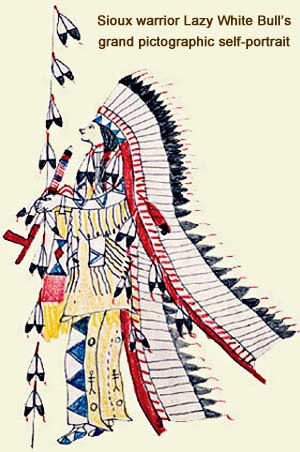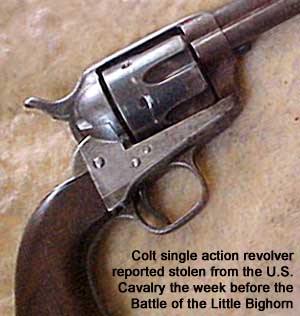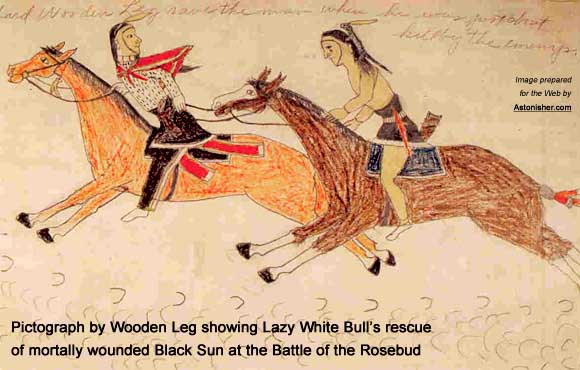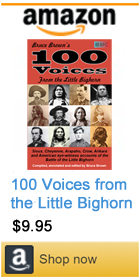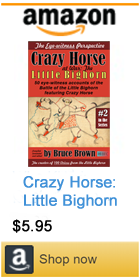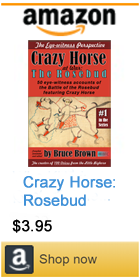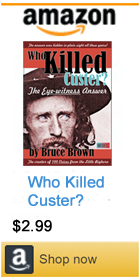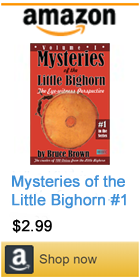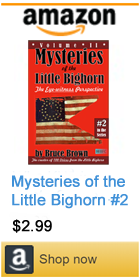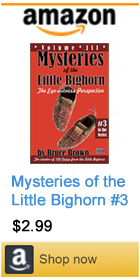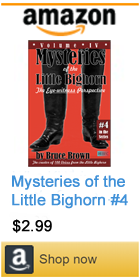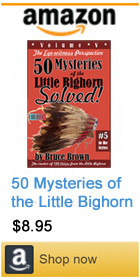|
||||||||||||
Bruce Brown's 100 Voices... Lazy White Bull's Story of the Battle #1
LAZY WHITE BULL'S ACCOUNT
THE SANS Arcs was his camp circle. White Bull and his wife lived in this lodge. The wife's name was Holy Lodge. She was a Sans Arc. That is the reason for White Bull being there.2 White Bull's lodge was on the north side of the circle. The one's on each side of White Bull's lodge were relatives. The wife's father was Iron Whiteman.3 White Bull got up about daybreak and took his fatherin-law's horses up in the breaks. There were forty in all. Eighteen were White Bull's. Five of the eighteen were running horses -- four mares and one mule -- and the rest were geldings. He took them north of the camp along the river. He took [them] about half a mile from camp. He was watching the horses for a while. About 8 o'clock, White Bull came home for breakfast; then he went back for the horses after breakfast and had his gun and two cartridge belts [with him]. White Bull was trying to head off his horses. They were on the west side. They were about 125 yards from the water. While he was herding horses, he heard a man yell, and so he went up the river to where the Hunkpapas were, and Sitting Bull was there. They were up to something, and so White Bull started his horses home and got one of his running horses, and he heard guns shooting and saw the women running and yelling, ready to leave. His father [Makes Room] was on the north side of the Hunkpapa camp, and Sitting Bull was on the southside. When the soldiers came to the crossing, they were seen, and by the time they crossed, they had most of the horses caught and White Bull was at the Hunkpapa camp. White Bull was riding a bay horse and [carried] a 17 loading-gun [Winchester]. When White Bull got to Sitting Bull's place, White Bull's two brothers were there. Sitting Bull said, "Get busy and do something!4 The first shots of the soldiers went through the teepees, so no one was hurt, but Three Bears was killed down by where White Bull was.5 When he [White Bull] heard the man across the river, the man had his boy with him and the boy was killed, and this was about three miles from the camp. The boy's name was Deeds [AKA Trouble or Big Trouble]. Brown Arse [AKA Brown Back or Brown Ass] was the boy's father.6 [Note: Drags The Rope said Brown Back was Deed's older brother, not his father.] After Three Bears was shot, Dog with Horns was shot.7 A lot of people there together. White Bull does not know [for sure], but he thinks that there were three [Ree] Indian Scouts that took away about ten head of horses.8 Chased by Owl was killed. White Bull was killed [Note: the deceased White Bull was a Hunkpapa, while the speaker, Lazy White Bull, was a Minneconjou] . When they start fighting, Three Bears [and] Dog with Horns were killed, and after they started for them, White Bull and Swift Bear were shot by a Ree Scout.9 White Bull does not know the Ree, Bloody Knife.10 A Cheyenne was killed after Swift Bear and also by a Ree soldier. White Eagle was killed also.11 The Ree's name that shot the two Indians was Buffalo Cloud.12 The Ree was shot down and the Sioux captured the Ree's horse first, and then they went for the Ree and he shot two of them. The Sioux was White Eagle [and] Elk Stands on Hill Top [who] were killed; but they don't know who killed [the] Ree. The Ree that killed Elk Stands on Top was killed right afterwards.13 [Note: see The Twisted Saga Of The Unsung Seventh Cavalry Scouts for more info.] Some of the white soldiers would shoot from the saddle. When the soldiers shot and moved the Sioux back a little, and then they set up a flag, and White Bull said [that] who is a brave man will get that flag. But no one went, and in a few minutes the soldiers came and got it again. The soldiers got as close to the camp as the store from here. These soldiers were not Custer's. When they got off and set their flag and the Indians were about to chase them, and then the soldiers took their run; and there were about three [soldiers] who could not get across [the river] and [who] ran down the west side, and White Bull chased them until the leaders stopped. White Bull did not kill anything; but he wanted to kill a soldier on a gray horse, but he could not hit him.14 After they stopped from chasing these three [soldiers], they rest, and Custer was coming but they rest their horses and then started toward Custer, and they shot two of Custer's men before the army stopped. The women and children were about half a mile [away], and Custer stopped about straight across from the camp. There were four companies. Custer was in the 2nd from the north.15 After they were killed, [all] that took a look and (on the map) was where Custer was laying. The Indians see the women folks, and they stay between the troops and the women. White Bull was on the east end, and White Bull took a center run, but they did not hit him. The second time, he said he was not going to turn back. He charged on the last company. When White Bull start, the rest of the Indians start, and the last bunch run to the 2nd bunch, and the 2nd runs to the 3rd, and all the soldiers get on their horses, and when they [the Indians] were between the two companies, White Bull pulls a white [soldier] off his horse.16 When the 1st reached the 2nd [company], they don't run straight. Some run toward the river and they were all killed. White Bull killed a man before he pull the man off his horse. The 4th company went to the 3rd co[mpany] in the draw and they don't go any farther.17 Between the 2nd and 3rd [company] -- after he pulled the man off his horse -- White Bull captured a gun and belt from a dead soldier. White Bull had two 1st [coups]. The 4th co had lost their horses. They had white horses -- that was the grey horse troop.18 White Bull was chasing horses, and an Indian came in front of White Bull and cut him out. The 3rd company had bay and white horses at the time, but they soon lost them. Sorrels, bays, and whites were in the 3rd company from the 1st and 2nd.19 Before the 3rd company turned their horses loose, they ran south and all except one was killed; but the horse was shot from under him. This might have been the man where the man fought from the hill. Butler must have been from the 2nd or 3rd company, but White Bull did not see him. White Bull did not.20 Down at Reno there was two soldiers [who] got away, and the Indians killed one and the other killed himself, according to Did Not Go Home, who chased them.21 The white men from the 1st and 2nd company were on horseback. They still had their horses when they got to the 4th company, and then they run from the 3rd company and they were all killed down the draw. The last one killed was close to the river.22 This made White Bull feel good, and he was picking up head feathers right along. White Bull is going to wear all of his feathers sometime. It is the custom to wear only one or two. Some of the societies, when they would sometime [meet], wear all theirs, and if they shot [an enemy] one, two, or three times they would wear a red feather.
When he [White Bull] rode thru, the space was about as close as [a]cross [to] this house. He was leaning on top of the horse, leaning down. When Indians lean on the side of the horse, they would hold both hands on the horse's mane. White Bull has heard that they shot [from] under the horse's neck. He was riding bareback and had a bridle on the horse. After he [White Bull] goes thru, he joins the group of Indians on the other [west] side, and the 3rd company started running down the hill, and White Bull ran over a soldier on horseback. The Indians got as close as from here to White Bull's house.24 [Note: here are some other accounts of this dramatic moment in the battle.] The boys keep encouraging each other, saying, "try!" After he ran over the soldier, White Bull's horse was shot down and White Bull was on foot. Then he saw Bear Lice coming, leading one of the soldiers' horses. It was a bay, and Bear Lice gave White Bull this horse and start again and started for a soldier; but the soldier was shot before White Bull got there, but White Bull struck him.25 After he struck the soldier, [White Bull saw] (another) was stand[ing], protecting himself; so he jumped off the borrowed horse and started for him on foot. White Bull was about as far from the soldier as from here to the hall. The soldier was shooting, and White Bull got close and the soldiers threw his gun at him, and White Bull started to fight. White Bull had a gun in his right hand and whip in [his] left hand, and the soldier was trying to knock the gun out of White Bull['s hand]; but White Bull hit him in the neck, and the soldier had on a coat.26 White Bull was yelling, so Crow Boy and Bear Lice came over to hit the soldier, and they hit White Bull also [accidentally]. The reason they called Crow Boy: White Bull said, "Hey-Hey, come over and help me!" twice. This was when the man was about to get White Bull's gun. It was the custom to call out when they struck a man. They call, "White Bull to strike the enemy first!" and 2nd, or 3rd. Some [Indians] say to touch this enemy [is] clear enough [indication that the ground rules have been met for earning a coup].27
With horses brought, White Bull [was placed] on his horse. There were about ten soldiers that chased White Bull up the hill. These were the last ones to live. The fight lasted about an hour, the sun was before noon. There were a few cartridges [left] in the [captured] belts. The soldiers wore caps. They brought White Bull to his father's lodge. Their camp had not been set up. After he got home to his father, Sitting Bull was there and [he] had medicine so he put it on and [took] some buffalo fur and wrapped it up. The announcer said the camp would be there. Some of the women brought their teepees, but some had to go back after them. The medicine was made of root, and it was called "wounded medicine."29 White Bull said that [it] was a great battle, and he liked it. During the fight and after the war, the women folks were crying, so White Bull's father announced not to cry but to sing. There is some certain song for the Sioux men that were killed. His father saved a song. The man's name was Elk Stand on Top for whom his father sang. "The people call him Elk Stand, and he was a brave man, but he is all gone now. Sometimes they call him. Elk Stand on Top, they got him for a brave man, but his [spirit] is gone now."30 Sitting Bull said to White Bull, "My nephew, you must be careful!-sometime you may be killed." Sitting Bull was across the river fighting, White Bull heard, and [he] did not hear what Sitting Bull did. Indians have an argument: some say Sitting Bull was with Long H[air], and some say he was not there.31 White Bull's father was at home watching the women and keeping them together. White Bull's father was Makes Room [who] was fifty. Then most of the men were young in this battle. Only half of the men went. Makes Room never did get in the fight. White Bull never saw Jumping Bull. White Bull never saw [any] chiefs in the fight.32 After they bandaged White Bull's leg, noon time came, and after dinner Sitting Bull put medicine on White Bull's wound. White Bull wanted his horse and went back to the battle ground to get his saddle and leggings that he had thrown off; and they went over to where they had been [when] the most close fighting was going on.34 Bad Soup pointed at Custer and said that he [Custer] thought he was the greatest man in the world, but there he is. This [Bad Soup] was Sitting Bull's brother-in-law. All of Custer's clothing were taken. This man had no mustache. [Note: the fact the this man didn't have a mustache meant he wasn't Custer. See Who Killed Custer - The Eye-Witness Answer for more info.] White Bull got his saddle and leggings and got two pair of [soldiers'] pants. Washed them in the river and brought them home to his father.35 White Bull did not see anyone cut up the dead soldiers, but he thinks that maybe some of the parents of dead Indians might have gone up there and did it. These are the dead [Indians] in [the] Custer fight: 1. Bear with Horns Sans Arc 2. Lone Dog Sans Arc 3. Elk Bear Sans Arc 4. Cloud Man Sans Arc 5. Kill Him Sans Arc 6. Rectum Hunkpapa 7. Many Lice Oglala 8. Red Face Hunkpapa 9. Bad Light Hair Oglala 10. Hawk Man Hunkpapa 11. Young Skunk Oglala 12. Left Handed Cheyenne (Son of Ice Bear, nephew of Kate Bighead)36 13. Owns Red Horse Cheyenne 14. Flying By Cheyenne (Hair People Band) 15. Bearded Man [the Cheyenne war chief Lame White Man] Cheyenne. This man made a rush and the soldiers kill him right there. He was killed among the soldiers, and they [the Sioux] thought he was an Indian Scout, so they scalped him and [afterwards] found out they were wrong; and it was Little Crow, brother of Chief Hump who got the scalp.37 17. Swift Cloud Cheyenne These [following] two men were killed by the pack train on the bluffs: 1. Dog Back Bone Minneconjou. This man was shot about two steps in front of White Bull. 2. Long Road Sans Arc These are the ones killed down at Reno in the bottom: 1. Three Bear Minneconjou 2. Dog with Horns Minneconjou 3. Chase by Owl Two Kettle 4. Swift Bear Hunkpapa 5. White Bull Hunkpapa 6. White Eagle Oglala 7. Elk Stand on Top Sans Arc 8. A Cheyenne was killed, [name] unknown.38 They brought all of them to camp and put all the dead in a big teepee. Some were buried other places. They did not take their dead with them to White Mountains; but two died on the way and they were buried where they died.39 After White Bull came home with his saddle and leggings, then he went [to] one of the bluffs, and staid there all night and came back after dinner and went to sleep; but his father woke him up and told him that something was going to happen. So White Bull went over on the hill where there were some other men, and they told him that a scout told them that some soldiers were coming. So White Bull, Wounded Lice and one other man started out to scout and they saw a soldier and he ran. Then they found some [more] soldiers. They were on the west side of the river, about 9 miles north of the fight. They were horse soldiers and White Bull did not see any more.40 They rest a while and watched the soldiers, and he did not scare anyone. Then they saw some horses, and White Bull was leading [in the charge] and they got about thirty head of horses. They went along a short way and then they met a group of Indians, and they were moving because there was soldiers coming, and they were camping at the place where they had the sundance. The Indians asked how many soldiers were there and he said that there was not as many as they had just killed.41 So these Indians went on back to camp with these thirty horses. The reason the soldiers did not shoot was that the horses were out of range of camp. After the three got back to camp, they found out that the camp had moved on, so they divided the horses. It was about sundown and White Bull tracked his camp and found some food and ate around a [deserted] tent place, and went on until he found the camp about dark and he heard his father singing: "White Bull, when ever there is a [lot of] people to see you, you do something [brave], and I sure like you." The soldiers were not marching. The horses did not have shoes on. Before they got to home, White Bull met [some] men and they asked him for a horse, but White Bull told him to get some for himself. White Bull got seven coups. Coup counts if horse hits man. Coups of White Bull: 1. First I saw someone shot one soldier, and as I reached him he fell off [his horse], and I got off [and] counted coup and took his pistol and cartridges, and Indians [were] still charging. 2. One [soldier] had tired horse and was trying to get rifle around to shoot White Bull, but he counted coup and dragged him off his horse. 3. A soldier on foot and pointing gun in all directions. Someone shot him, and I run up and counted coup. 4. Soldier on foot and points gun to Indians; so they could not get him, and [finally] White Bull rides him down and counted coup. 5. A soldier afoot, same as [number] "4". Soldier aims [at] White Bull and does not fire; then, when White Bull gets close, he throws gun at White Bull, and White Bull wrestles with him. After [wrestling] so long, [White Bull] gets on top and hits him on head. Wrestling soldier tries to take White Bull's gun from White Bull's left hand, and soldier about gets it. So, White Bull hits him in face with whip, and soldier lets go. Then, [the soldier] comes back with fists and hits White Bull on jaw and shoulder, then grabs his hair and tries to bite White Bull's nose [who] yelled all the time to scare soldier. Then White Bull hits him several times on the head and pushed him over, and takes his gun and cartridge belt and counted coup. [The] soldier did not make any noise, and as White Bull was afraid he could not get the best of the soldier, he yelled all the time to scare the soldier. 6 and 7. Bunch [of] soldiers on foot came in draw, and White Bull and another [Indian were] ahead and get off horses, and they fought them and shoot them as they come. [They] then jump in [draw] and take guns from them, and more soldiers come; so the two Indians roll out of [the] stream [bed], or draw, and got away, [having] counted coup twice. Richard G. Hardorff's Notes: The White Bull Interview Editorial note: This interview was conducted in 1930 by Walter S. Campbell. The interview resulted in nineteen letter-size pages of text, recorded in longhand by Campbell's stenographer, Dallas McCoid, Jr. The interpreter was Sam Eagle Chase, an educated Lakota. The following is a transcript of the original manuscript. NOTES: 1 Known among the Lakotas as Pte San Hunka, Lazy White Buffalo is perhaps best known to the whites as Joseph White Bull whose life was immortalized by Stanley Vestal in Warpath, the True Story of the Fighting Sioux, Told in a Biography of Chief White Bull (Boston, 1934). A Minneconjou Lakota by birth, White Bull was the son of Makes Room and Pretty Feather Woman, and a maternal nephew of the great Hunkpapa, Sitting Bull. The present interview was probably conducted in 1930. It is contained in the Walter S. Campbell Collection, University of Oklahoma, box 105, notebook 23. For additional information on this and the 1932 White Bull interview, see Campbell's biography by Ray Tassin, Stanley Vestal, Champion of the Old West (Glendale, 1973), pp. 159-70, 184-85, and also the excellent introduction by Raymond J. DeMallie to the new edition of Warpath (Lincoln, 1984), pp. v-xxiii. 2 Holy Lodge was married to White Bull from 1871 until her death in 1894, the union resulting in the birth of two sons. In 1876, White Bull's lodge consisted of four people: himself, Holy Lodge, their infant son, and a son from a previous marriage with the Sans Arc, Rattle Track Woman. White Bull's matrimonial history included 15 wives, while four times he tried to have two wives at once. See White Bull Interview, (1932), box 105, notebook 24; Tassin, Stanley Vestal, Champion of the Old West, p. 167. 3 White Bull's father-in-law, Iron Whiteman, was a Sans Arc tribal leader and a man held in considerable esteem. See White Bull Interview (1932). 4 According to White Bull, "Reno hit camp about 10:30. Horses all out on prairie. Known that soldiers would come that day. Scouts saw them coming at sundance ground. Three scouts, one of which [was] Owns Bobtail Horse [Bobtailed Horse]. Scouts saw Custer coming three days before [on June 22]." See White Bull Interview, (1932), notebook 24. [Note: see Bruce Brown's introduction to American Horse's account of the battle for more info on the advance intelligence of Custer's movements that came to the free Sioux and Cheyenne by way of their far roving scouts.] Along with the Hunkpapas camped a small number of Blackfoot (Siha Sapas) and Two Kettle (Oohe Nonpas) Lakotas, and although it is generally assumed that Reno attacked the Hunkpapas, he actually hit the Blackfoot whose lodges were pitched on the southern side of the circle. See Interview with Pretty White Buffalo Woman in Graham, The Custer Myth, p. 183; Flying By Interview, 1912, Walter Camp Manuscripts, Indiana University Library, p. 348; White Bull Interview, (1932), notebook 24. This is the first intimation that the Minneconjou chief, Makes Room, may have had three sons. However, the names of only two are known: White Bull and One Bull. The latter, known among the Lakotas as Tatanka Winjila (Lone Bull), was born near Bear Butte, South Dakota, in February, 1853, and at the age of four he was adopted by his uncle, Sitting Bull. In 1876, One Bull was married to the Hunkpapa, Red Whirlwind Woman, their assigned lodging place being adjacent to the teepee of Sitting Bull. One Bull passed away on June 23, 1947. He lies buried next to his wife in the mission cemetery on Little Oak Creek, near Little Eagle, South Dakota. For capsule biographies of these two sons of Makes Room, see Stanley Vestal, "White Bull and One Bull -- An Appreciation," (Chicago) Westerners Brand Book 4 (1947):45, 47-48. 5 Three Bears was an elderly Minneconjou who died from the effects of a gunshot wound, received at the outset of Reno's attack in the valley. See White Bull Interview, (1932), notebook 24. 6 Identification of these two tribesmen, and the reconstruction of their activities on June 25, is complicated by a mass of conflicting evidence. A careful screening of the available evidence seems to suggest that they were father and son, and members of the Sans Arc Lakotas. The old man is variously identified by the picturesque English names of Brown Ass, Brown Back, and Pants, while the young boy was called either He is Trouble, Plenty of Trouble, Business, Deed or Deeds. Both of these men were seen near the divide on the morning of June 25 by Lt. Charles A Varnum. Yet, only the father, Brown Back, would return to the camp sites in the valley-his ten-year-old son was mysteriously slain before reaching the safety of the Indian village. See Hardorff, "Custer's Trail to Wolf Mountains: A Reevaluation of Evidence," Custer and His Times. Book Two, pp. 110-11. 7 Dog with Horns was a young Minneconjou whose reckless conduct resulted in his death from a gunshot in front of Reno's retreating skirmish line. See White Bull Interview, (1932), notebook 24. The death of this Lakota was probably witnessed by the Ree, Young Hawk, who recalled years later that "one Dakota charged the soldiers very closely and was shot about sixteen feet from the line. He rode a sorrel horse with a bald face and his tail was tied [up] with a piece of red cloth." Libby, The Arikara Narrative, p. 96. 8 On the flat on the east side of the river and nearly opposite the present town of Garryowen, six Ree Scouts captured a herd of 27 ponies and 2 mules which they drove onto the bluffs near Reno Hill, hotly pursued by the angry Sioux. See Hammer, Custer in '76, pp. 180, 184. 9 During Reno's retreat from the valley floor, two Hunkpapas, White Bull and Swift Bear, were shot and instantly killed, while the Two Kettle Lakota, Chased by Owl, was fatally wounded. See White Bull Interview (1932), notebook 24. The double slayings of White Bull and Swift Bear may have been accomplished by the Ree, Young Hawk, a very brave, young man only 17 years old in 1876. See Libby, The Arikara Narrative, pp. 100-101. 10 Since White Bull was a Minneconjou, who resided among his Sans Arc in-laws, he would not have been familiar with all the diversified relations of the Hunkpapa kinship units. Bloody Knife was born of a Hunkpapa father and a Ree mother. According to his paternal nephew Has Horns, he was well known among the Standing Rock Hunkpapas. For a biography of this Ree Indian, see Benn Inniss, Bloody Knife! (Fort Collins, 1973). 11 Of the seven Cheyennes killed at the Little Bighorn, only two were slain during Reno's retreat: Roman Nose, killed on the west side of the river near the ford, and Little Whirlwind, killed on the flat on the east side. The Cheyenne slain by the Ree was Little Whirlwind. See Marquis, Wooden Leg, p. 268. White Eagle was an Oglala Lakota who was slain near the foot of Reno Hill, presumably by this same Ree. 12 Since the name Buffalo Cloud was a Sioux appellation, the identity of this Ree cannot be established. The muster rolls of the Arikara Scouts carry names which are native to the Rees only. Buffalo Cloud is depicted in a pictograph by Amos Bad Heart Bull in Blish, A Pictographic History of the Oglala Sioux, p. 212, its text disclosing that the Ree spoke Lakota. 13 Elk Stands on Top, also identified as Elk Standing High, Alone, Above, or just Standing, was a brave Sans Arc man whose death and the slaying of his killer are depicted in Blish, Pictographic History, p. 247. For an eyewitness account of this incident and further details, see the interview with the Oglala, Eagle Elk, in this volume. 14 This soldier may have been a trumpeter, all of whom were assigned grey horses. 15 White Bull's count of only four companies seems to suggest that two of Custer's five troops may have moved together as one unit. White Bull's 1932 interview (notebook 24) reveals: "Where we were standing on side of hill, we saw another [body of] troop[s] moving from east to north where [fleeing] camp was moving, and we charged; it was Custer. We went down east side of the river and we rode straight to Custer. [It] was three miles from where we left Reno to Custer. Chased Custer indefinite distance. Could not see Custer as he was in company. But [it] was about [a] mile from Custer to hill. Still riding in a walking and trotting [pace], still close together. Custer did not stop before they reached [Calhoun Hill?]. They kept shooting as Custer kept moving." 16 White Bull's 1932 interview (notebook 24) disclosed: "Some Indians went up draw to Custer, White Bull with them-a lot of them. When up in draw, Custer saw them and took shots at them, so they moved back south a ways. Custer at standstill and get off horses to shoot; then get back on [and] made four companies, and one company was shooting at them in the draw. Doesn't know color of horses in [latter] company. On with the battle! After they shoot us back, I left my bunch [and] work around to the east and throw in with another, and now many bunches on south and west took charge at one company and drove them back to where Custer monument [now] is. There was much dust, and we rode among them and pulled them off their horses." The draw mentioned is probably the present Deep Coulee which runs south of Calhoun Hill, and which is not to be confused with Deep Ravine which lies to the north of it. Considered a deed of great valor, a "center run" was a mounted display of defiant contempt for adversaries, which solo exhibition served to enhance one's martial reputation. Often possessing powerful medicine bundles, the individuals who undertook such a run had the utmost confidence in their spiritual protectors. For an example of such a Cheyenne individual, see DeMallie, The Sixth Grandfather, pp. 190-91. White Bull charged the first company, which was probably L company, deployed on Calhoun Hill, near which White Bull attained his first coup. 17 The draw which sheltered the third company is undoubtedly the present Deep Ravine which bottom contained the remains of some 28 white men after the battle. Some of the survivors of the fourth company, on the hill, would also in vain try to seek shelter in this same ravine at the end of the battle. Elaborating on the death of his second victim, White Bull recalled in his 1932 interview (notebook 24): "I jerked a soldier off his horse, and after he fell, Crazy Horse counted second coup, and later [he] ran through all [of] them. Crazy Horse [wore] no feather [bonnet]; [he had] loose hair, ordinary hair, face spotted, [and he] carried a gun. Crazy Horse counted coup on White Bull's second [victim]. Crazy Horse ran through infantry [some time] after [having] counted coup and followed by White Bull, from north toward west." The facial painting of Crazy Horse consisted of a red zigzag line and white dots, revered symbols of the hail and lightning powers of the thunder beings. According to his cousin, Eagle Elk, Crazy Horse's hair adornment consisted of a single eagle feather, worn in combat with the tip down, on the back of the head. See Hardorff, The Oglala Lakota Crazy Horse, p. 20. White Bull's reference to infantry identifies a company which had lost its horses and which fought on foot. 18 Company E. was assigned grey horses which are mentioned in nearly every Indian narrative account. For a listing of White Bull's coups, see the editorial addendum at the end of this interview, and also the pictographs in James H. Howard, The Warrior Who Killed Custer: The Personal Narrative of Chief Joseph White Bull (Lincoln, 1968), pp. 51-62. Additional pictographs of his exploits may be found in Vestal, Warpath, after p. 196, and also in Vestal's article, "The Man Who Killed Custer," American Heritage (February, 1957): 4-9, 90-91. Questioned about the spoils of the battle, White Bull disclosed in his 1932 (notebook 24) interview: "(Custer's horses) not fast and did not notice if tired. White Bull got one sorrel, good horse; this was not Custer's; had saddlebags on it, shells and bullets in saddlebags. [He] got good gun. No trouble with cartridges sticking. Had gun been fired when he got it? Yes, empties all. Not many cartridges around soldiers, and [he] got some pistols that had not been used. Many cartridge belts and few used." 19 The last survivors seemed to have fled from the fourth company which huddled at the monument site. According to White Bull, ten of these surviving soldiers tried to seek shelter in Deep Ravine. 20 Company C had light sorrels, Company E grays, and Companies F, I and L bays. 20 Born in Albany, New York, in 1842, James Butler was a first sergeant in company L who had served in the Seventh Cavalry since 1870. Of courageous character, Butler was found on the heights west of Luce Ridge, his mutilated corpse lying amidst numerous cartidge shells. See Hammer, Men With Custer, p. 228. Actually, only a few troopers of the third company attempted to escape south. The Oglala, He Dog, told Walter Camp in 1910: "when the [white] men rushed from Custer's last stand toward the river, the dismounted ones took to the gully, and the mounted ones tried to get away to south toward Finley [marker on west end of Calhoun ridge]." See Hammer, Custer in '76, p. 207. According to the Lakota, Lone Elk, only nine of these fleeing troopers were mounted, while the Cheyenne, Two Moons, recalled just five. However, only one of these few, Corporal John Foley of C Company, managed to ride as far as Medicine Trail Coulee where luck ran out on him and he allegedly suicided. See Hardorff, Markers, Artifacts and Indian Testimony, pp. 29-30, 59. 21 The individual, Did Not Go Home, has not been identified. Vestal, Warpath, pp. 200-201, states that Lt. Henry H. Harrington was this suicide. This is obviously an erroneous conclusion since the incident took place on Reno's battlefield. 22 There exists sufficient evidence to conclude that the third company consisted of E troopers and survivors from Companies I, L and C, the latter three originally deployed farther southeast. See for example Grinnell, The Fighting Cheyennes, p. 353. White Bull's narrative makes clear that the third company was dismounted, and that it left Custer Ridge well before it was followed by the survivors of the fourth company, The fourth company was probably F Company, of which some 14 troopers had been slain around Custer, a quarter of a mile farther northwest. See Hammer, Custer in '76, p.139. 23 Reference is made to a pictograph drawn by White Bull, but which is not reproduced in this volume. White Bull's statement about Crazy Horse's lack of courage is contradicted by his 1932 interview, in which he stated that Crazy Horse ran through the "infantry" and that he, White Bull, followed him, the movement being across Custer Ridge from north to west. For evidence of Crazy Horse's charge, see the Scott interviews with Red Feather and He Dog, and also the latter's interview with Walter Camp, in Hammer, Custer in '76, p. 207, which reveals: "At Keogh [I Company] is where Crazy Horse charged and broke through and split up soldiers into two bunches. Horses stampeded toward river, getting away from soldiers." The charge of these two men may well have been the one referred to by the Cheyennes. See Grinnell, The Fighting Cheyenne, p. 351. [Note: see the Crazy Horse at the Little Bighorn and Crazy Horse at the Rosebud Guided Tours for more info on Crazy Horse as a warrior.] 24 The third company retreated to the river sometime after Crazy Horse and White Bull charged across the ridge. This charge may well have stampeded the grey horses. See DeMallie, The Sixth Grandfather, pp. 191, 193. 25 The sequence of the narrative suggests that this action took place in and around Deep Ravine. 26 It was this incident which eventually led to Campbell's conclusion that White Bull had slain General Custer. This belief found expression in the revised edition of Sitting Bull, published in February, 1957, and which was followed in the same month by Campbell's article, "The Man Who Killed Custer." This sensational claim did not go unchallenged very long, because the following year Edgar I. Stewart contested its validity in "Which Indian Killed Custer?" Montana the Magazine of Western History (Summer, 1958):26-32. The effect of Stewart's provocative article resulted in a response by Reginald Laubin, and a rebuttal by Stewart, the correspondence being published under the editorial caption, "More Rumblings from the Little Big Horn," Montana (Winter, 1958):57-61, and which ended with Laubin's rebuttal in Montana (Spring, (1959):47-8. However, Campbell was not alone in his belief. In 1968, James H. Howard edited and published The Warrior who Killed Custer: The Personal Narrative of Chief Joseph White Bull, which title and contents are indicative of Howard's conviction. Unfortunately, Howard did not examine White Bull's interview notes. Although Custer sported a droopy mustache, White Bull's statement reads that his victim, alleged by Campbell to have been Custer, did not have a mustache! Of course, this minor detail was omitted from all of Campbell's published works for obvious reasons. However, in view of Campbell's professional reputation, I agree with Raymond J. DeMallie who concluded that Campbell's "motivation was not to deceive, but rather to honor a man [White Bull] whom he had respected in life and whose memory he cherished." See DeMallie's introduction to the new edition of Warpath, pp. xxi-xxii. [Note: kudos to Hardorff for succinctly dissecting the intellectual fraud Walter S. Campbell tried to perpetrate on Lazy White Bull's behalf. See Who Killed Custer -- The Eye-Witness Answer for more info.] 27 The individual named Crow Boy has not been identified. He may have been a Crow captive raised among the Sans Arcs. 28 The draw referred to was probably Deep Ravine. Note that White Bull was going up the hill after his alleged encounter with General Custer. It seems unlikely, therefore, that White Bull was ever at the monument site where Custer's body was found-during the battle. 29 White Bull's 1932 interview (notebook 24) reveals: "Did not know who white general was. Did not see him. Soldiers not very good fighters, and most were drunk and scared when [they] saw so many Indians. Did not know of whiskey on soldiers, nor smell it afterwards." Asked to comment on the white men's way of fighting, White Bull responded: [They] don't know how to fight. Saw lots of them. Mistakes? [They] should act more lively like Indians; but [they get] too many orders and don't try to save themselves. They stand up straight and run straight-easy to shoot them; half obey orders and half don't (deploying, he means?) Either is just shooting, but in hand-to-hand fighting, Crow [Indians] worse." 30 White Bull's 1932 interview (notebook 24) discloses: "War started about 9 or 10, and lasted till about noon. Never did see Sitting Bull in whole fight. Sitting Bull never told White Bull about his part in fight. When soldiers first came, [did] Sitting Bull take one twin and ride away? Must be so as Sitting Bull and I were there; then I left and did not see Sitting Bull again. Ever know Sitting Bull to be a coward? No. Was Sitting Bull on hill making medicine during battle? No. Just talk. Sitting Bull shot through foot and [it] was not healing right, so Sitting Bull could not run. One reason Sitting Bull not in fight, if not, [was because he] was taking women and children back, then went to fight. One Bull may know." One Bull was White Bull's brother, and he explained (Campbell Collection, box 104, item 11): "Sitting Bull was back on the hill on the edge of the battlefield, sort of directing things tho he himself did not go into the fight at all." During the chaos of Reno's attack, one of Sitting Bull's twins was accidently left behind in the deserted family lodge. This child was later given the name Abandoned One. However, Sitting Bull's biographer, Walter Campbell, took offense at the thought that such an incident could have happened. Seeking to explain the infant's name, Campbell stated that the appellation, One Who Was Left, was given to the child by its paternal granduncle, Four Horns, in commemoration of an incident when he himself was left behind in 1843. See Vestal, Sitting Bull, Champion of the Sioux, p. 177. Convincing as this explanation may be, however, the facts do not support Campbell's conclusion. E. H. Allison, who had married a Hunkpapa woman, had learned the following: "Sitting Bull's own wife had twin babies three weeks old [in June, 1876], both boys. She was so frightened that she forgot she had twins. [She] seized only one and fled with it for the hills, when an acquaintance asked who had the other twin. She then realized what she had done. Passing the child she carried to her neighbor, she ran back to her teepee and brought away the other twin. The one she carried away first was named Yuha Nanpapi. The one left in the lodge was named Ihpeya Nanpapi. The word Yuha means to hold, to have, to possess. The word lhpeya means to cast away, to abandon, to lose. Nanpapi [means] they fled. So there you have the names of the twins: Fled With and Fled And Abandoned. One [twin], Fled With, is still living and still bears the name given him on account of that event-an unimpeachable witness to the fact that the Indians were taken by surprise and that they fled in fear before the attack of Major Reno's command." Allison to Eli S. Ricker, 3/7/1906, Allison Correspondence, Ricker Collection, Nebraska State Historical Society. 31 After finding sanctuary in Canada, Abandoned One was named after a tribal chief of the northern Black Feet Indians. Known as Crow Foot, this boy was killed by Indian Police in 1890 for provoking hostilities during Sitting Bull's arrest. His twin brother, Fled With, later received the reservation name of William Sitting Bull. He passed away near Pass Creek, Pine Ridge Agency, in February of 1910. See Walter Camp Manuscripts, Indiana University Library, p. 346. 32 The name Jumping Bull was borne by Sitting Bull's father who was killed by Crow Indians near present Lemmon, South Dakota, in 1859. The individual referred to by White Bull was an Assiniboine captive who was adopted by Sitting Bull as his brother in 1857, and who was later given the honored name of jumping Bull. Listed on the agency rolls as Little Assiniboine, he and his son, Chase Wounded, were killed by Indian Police in 1890 while resisting the arrest of Sitting Bull. See Vestal, Sitting Bull, Champion of the Sioux, pp. 34-38, 301-302. 33 White Bull's combat pictographs mistakenly show him dressed in leggings. Comparison of the text appended to this interview with the text in Howard, The Warrior Who Killed Custer, will disclose variations in the details of White Bull's coups. 34 Close range combat probably occurred near Keogh's final stand, on Custer Hill proper, and in Deep Ravine. 35 White Bull's 1932 interview (notebook 24) reveals: "Where monument [now] stands, another Indian showed White Bull Custer's body; clothing had been taken away and Custer was lying naked. After shown Custer's body to White Bull, this Indian, Bad juice, [said he] often was with soldiers. Later, White Bull was watering horses and [he noted] one Indian had sorrel horse. White Bull [said]: `Is that a good horse?'and Indian said, `I know it is [a] good horse as it was Long Hair's.' Sound the Ground as He Walks [Noisy Walking] had Custer's horse -- a Santee, son of Inkpa Luta [Inkpaluta, or Red Top]. White Bull had never seen Custer before; neither other Hunkpapas, nor Sitting Bull, I think." Custer's body was found void of any clothing, the exception being his white socks and the instep of one of his leather boots. Two gunshot wounds were discovered on the body. One bullet had crushed into the left temple, half way between the ear and the eye, while the second projectile had entered his rib cage, just below the heart. Custer's corpse was subjected to only slight mutilation. In addition to a disfigurement of the genitals, the left thigh had received a knife slash which had exposed the bone. See Hardorff, The Custer Battle Casualties, pp. 30-31. 36 Left Handed was the Lakota name for a young Cheyenne boy known among his own people as Noisy Walking. He died on the evening of June 25 from the effects of a gunshot wound and severe stabbings, the latter inflicted by a Sioux who mistook him for an enemy Indian. He was the son of the respected Cheyenne, White Bull, who was known to the Sioux as Ice [or Ice Bear]. For an account of Noisy Walking's death, see the narrative by his aunt, Kate Big Head, in Marquis, Custer on the Little Bighorn, pp. 40-41. 37 Mustache, or Bearded Man, was the Lakota name for the Cheyenne war chief, Lame White Man, who was killed near the crest on the west slope of Custer Ridge. Hump was a band chief of the Minneconjou Lakotas. The proper translation of his name is High Back Bone (Canky Wakantuya), which means to convey one with a large breast. He probably was the eldest son of Chief High Back Bone, a renowned individual who was slain by the Shoshones in 1870. Of such national tragedy was this incident that it was recorded in nearly every Teton winter count. For Hump's account of the Custer Battle, see Graham, The Custer Myth, pp. 78-79. 38 The name of the unidentified Cheyenne is Black Bear. White Bull's list also omits the name of the young Sans Arc, Deeds. A considerable amount of new evidence on the Indian casualties has been compiled by the present author. This information will be published in the near future under the title, Hokahey! A Good Day to Die! The Indian Casualties of the Custer Fight, by the Arthur H. Clark Company. 39 The two Lakotas who succumbed to their wounds are Three Bears, a Minneconjou, and Black White Man, an Oglala. Their remains were sepulchered along Wood Louse Creek near the foot of the Big Horn Mountains. See DeMallie, The Sixth Grandfather, pp. 196, 198. 40 White Bull spent the afternoon and evening of June 25 on the northeast side of Reno Hill where one of the Lakotas, Dog's Back Bone, was killed by Reno's soldiers. On June 26, White Bull encountered the Montana Column near the present Crow Agency. This force of some 450 men was commanded by Colonel John Gibbon who was accompanied by the district commander, General Alfred H. Terry. See the White Bull Interview, (1932), notebook 24. For an excellent review of the march of the Montana Column, see Edgar I. Stewart, Custer's Luck (Norman, 1955), pp. 283-307. 41 Since these horses were unshod, they may have been stray ponies which were caught by the vanguard of the Montana Column, and which were subsequently recaptured by White Bull's party. The Crow Scouts attached to the column do not report the loss of any of their stock on June 26. See the "Journal of James H. Bradley," in Contributions to the Historical Society of Montana II (1896), pp. 223-24. Lakota Recollections of the Custer Fight: New Sources of Indian - Military History, compiled and edited by Richard G. Hardorff, The Arthur Clark Co., Spokane, WA, 1991, p 107 -126
According to Richard G. Hardorff, Lazy White Bull's name in Lakota actually translates as Lazy White Buffalo. He was also known as White Bull and Joseph White Bull. His parents were Makes Room and Pretty Feather Woman, and thus Lazy White Bull was a maternal nephew of Sitting Bull, and brother of One Bull. He should not be confused White Bull, the Northern Cheyenne leader (also known as Ice Bear or just plain Ice). Lazy White Bull fought in the actions he describes -- at both the battles of the Little Bighorn and the Rosebud -- and he was a major hero at the Rosebud when he rescued mortally wounded Cheyenne warrior Black Sun. But Lazy White Bull also sometimes claimed the brave deeds of others as his own. At the Battle of the Little Big Horn, for instance, He Dog remembered how Crazy Horse led the charge that split Custer's right flank, Red Feather told of how Crazy Horse rode between two split portions of Custer's embattled troops, and Left Hand said Crazy Horse "was the bravest man I ever saw." Lazy White Bull, however, claimed Crazy Horse was a coward and he -- Lazy White Bull -- was the one who performed this brave act, even though no one else reported seeing him do it. Lazy White Bull also claimed to have killed Long Hair, which wasn't true either, based on his own testimony that the officer he killed near the end on Last Stand Hill did not have a mustache. White Bull's claim that he killed Custer is not in the 1930 interview, but it is in the one conducted a decade or more later. Here is Richard Hardorff's succinct dissection of the false claims made by Lazy White Bull, and Walter Campbell on his behalf. Based on both the eye-witness accounts of the battle, and the subsequent developments on the battlefield that day, however, it appears that Custer was killed or seriously wounded at the very outset of the Custer Fight, probably by White Cow Bull at the river before Custer's troops were fully engaged in the battle. Later, in the confusion of the final moments of the battle, it is impossible to say who may have been riding a sorrel horse. Click here for Astonisher.com's Who Killed Custer -- Top Ten List. White Bull did honestly excel in one area though. With Amos Bad Heart Bull, he was among the leading pictographic artists among the Sioux during the early 20th century. -- Bruce Brown
|
||||||||||||



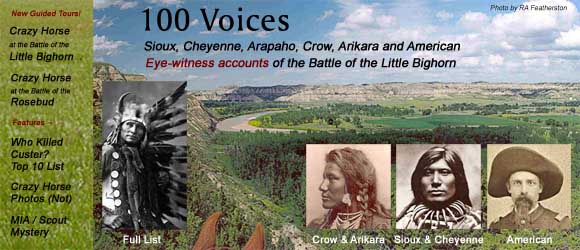
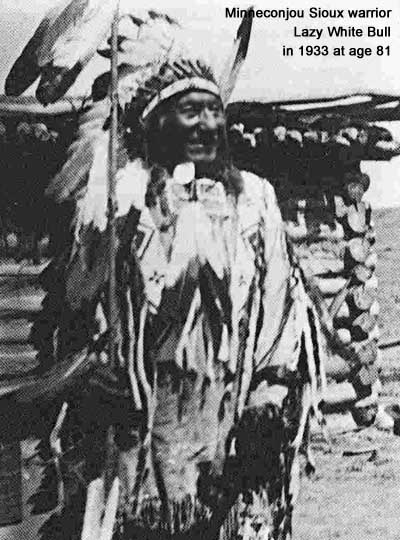 Cheyenne River Agency South Dakota
Cheyenne River Agency South Dakota 